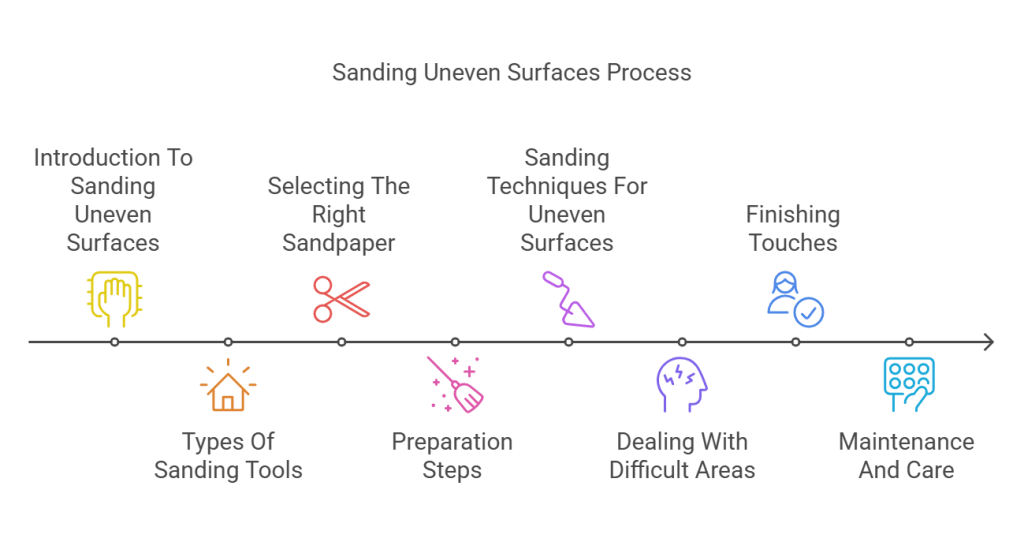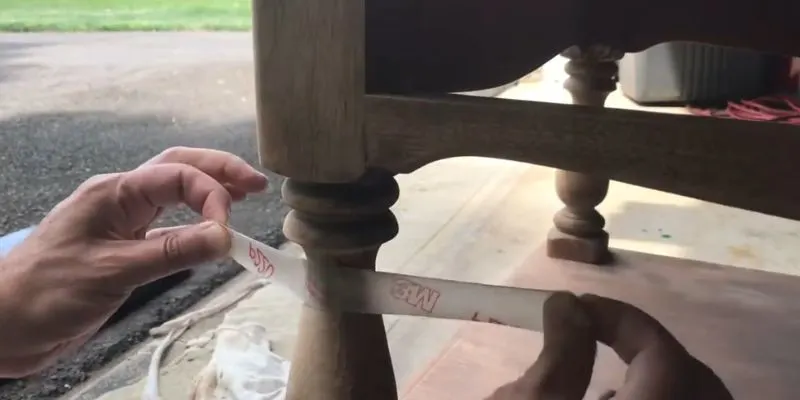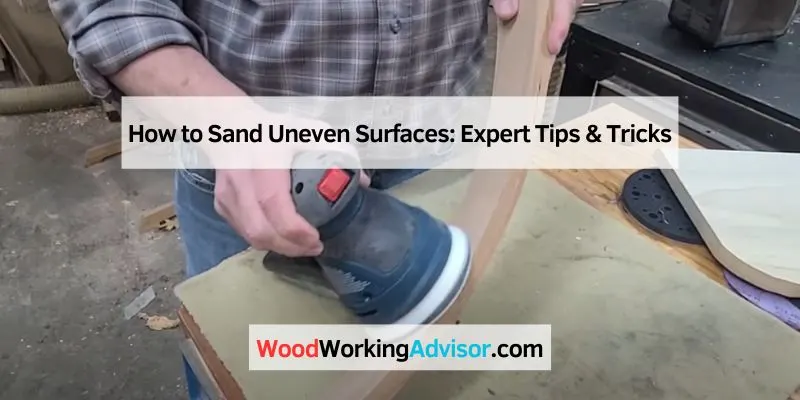To sand uneven surfaces, start with coarse sandpaper to level high spots. Follow up with finer sandpaper for a smooth finish.
Sanding uneven surfaces can be a daunting task, but with the right approach, it becomes manageable. Whether you’re working on wood, drywall, or metal, achieving a level surface is crucial for a professional finish. Uneven areas can lead to issues with paint adhesion and overall aesthetics.
Understanding the proper tools and techniques can save time and enhance the quality of your work. This guide will walk you through effective methods, ensuring a smooth and even result. With a few simple steps, you can transform any project and achieve a polished look that impresses. Let’s dive into the best practices for sanding uneven surfaces.
Introduction To Sanding Uneven Surfaces
Sanding uneven surfaces can be a real challenge. Proper technique is key to achieving smooth results. Uneven surfaces often cause frustration, leading to poor finishes. Understanding how to tackle these challenges is essential.
Using the right tools makes a big difference. Choose sanders designed for your specific project. Hand sanders are great for small areas, while power sanders work better for larger surfaces. Always start with a coarser grit to remove high spots.
Move in a consistent pattern. This helps avoid creating new uneven areas. Regularly check your work to ensure a smooth finish. Patience and practice will improve your skills over time.

Types Of Sanding Tools
Manual sanding tools are simple and effective. They include sandpaper, sanding blocks, and files. These tools allow for better control on uneven surfaces. They are great for small projects and tight spaces.
Power sanding tools make the job quicker. They include electric sanders, orbital sanders, and belt sanders. These tools work well for large areas and tougher materials. They save time and require less effort.
| Type | Uses |
|---|---|
| Manual Sanding Tools | Small projects, detailed work |
| Power Sanding Tools | Large areas, heavy materials |
Selecting The Right Sandpaper
Selecting the right sandpaper is crucial for a smooth finish. Different tasks require specific grit sizes. Grit size determines how rough or fine the sandpaper is. Lower grit numbers mean coarser sandpaper. Higher numbers indicate finer sandpaper, ideal for finishing touches.
Understanding grit sizes can help achieve the best results. For heavy sanding, use 60-80 grit. For smoothing surfaces, 120-220 grit works well. For final finishes, 320 grit or higher is perfect.
Choosing between dry and wet sanding depends on the project. Dry sanding is faster and easier for small jobs. It creates dust that may need cleanup. Wet sanding reduces dust and provides a smoother finish. Use it for delicate surfaces to avoid damage.
Preparation Steps
Start by cleaning the surface thoroughly. Use a broom or vacuum to remove dust. Wipe down with a damp cloth to eliminate any grime.
Before sanding, ensure the area is dry. Wet surfaces can cause uneven sanding. Allow enough time for the surface to dry completely.
Wear safety goggles to protect your eyes from dust. A mask will help prevent inhaling particles. Use ear protection if using power tools.
Keep a first aid kit nearby for any minor injuries. Ensure good ventilation in the workspace to avoid breathing issues. Always follow the manufacturer’s safety guidelines for tools.
Sanding Techniques For Uneven Surfaces
Applying the right amount of pressure is key for effective sanding. Too much pressure can damage the surface. Use a light touch to avoid gouging. Start with a coarse sandpaper, then move to finer grits.
Always follow the direction of the grain. Sanding against the grain may leave marks. Move steadily and keep the sander flat. This will help achieve a smooth finish.
For uneven areas, use a sanding block. This tool provides better control. Focus on the high spots while avoiding the low spots. Take your time and check your progress often.
Dealing With Difficult Areas
Dealing with corners and edges can be tricky. Use a detail sander for tight spaces. A hand sander works well on edges. Sand gently to avoid damaging the surface.
For curved surfaces, choose a flexible sanding block. This helps to follow the shape smoothly. Use sandpaper with a finer grit for a smooth finish. Always sand in the direction of the curve.
Consider using foam sanding pads for extra flexibility. They can reach into tight areas easily. Keep the sandpaper clean for better results.
Finishing Touches
Checking for uniformity is very important after sanding. Use a straightedge to find any bumps or dips. Run it across the surface to see if it sits flat. Mark any uneven areas with a pencil. This will help you know where to focus your sanding efforts.
Cleaning after sanding is essential for a smooth finish. Dust can stick to the surface and ruin your work. Use a vacuum or a damp cloth to remove all dust particles. Make sure the area is completely clean before applying any finish. This ensures better adhesion and a perfect look.
Maintenance And Care
Protecting the surface is important for long-lasting results. Always clean the area before sanding. Remove dust and debris to avoid scratches. Use a suitable sanding block or sander for better control.
Regular check-ups help maintain your surfaces. Inspect for uneven spots and damages often. Address issues quickly to prevent bigger problems. Keep tools in good condition to ensure effective sanding. This makes the process easier and safer.

Frequently Asked Questions
How Do I Identify Uneven Surfaces?
To identify uneven surfaces, visually inspect the area for dips and bumps. Use a straight edge or level for precise measurement. Mark any irregularities with chalk. This will help you know where to focus your sanding efforts for a smooth finish.
What Tools Are Best For Sanding Uneven Surfaces?
The best tools for sanding uneven surfaces include a random orbital sander and sanding blocks. These tools provide control and efficiency. For larger areas, consider a belt sander. Always choose the right grit sandpaper for your specific needs to achieve optimal results.
Can I Sand Uneven Surfaces By Hand?
Yes, you can sand uneven surfaces by hand. Hand sanding allows for greater control and precision, especially in tight spots. Use a sanding block to maintain even pressure. This method may take longer but can effectively smooth out imperfections.
How Do I Prepare For Sanding Uneven Surfaces?
To prepare for sanding uneven surfaces, clear the area of debris and obstacles. Wear appropriate safety gear, including goggles and a mask. Clean the surface of dust and grime. This will ensure better adhesion of sandpaper and more effective sanding.
Conclusion
Sanding uneven surfaces can transform your projects. By following the right techniques, you ensure a smooth finish. Always choose the appropriate tools and take your time for the best results. With practice, you’ll master this skill and enhance your craftsmanship.
Happy sanding, and enjoy the satisfaction of a job well done!

